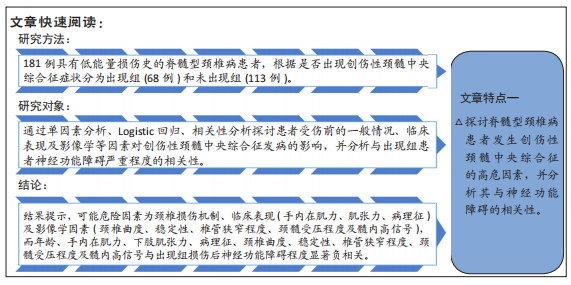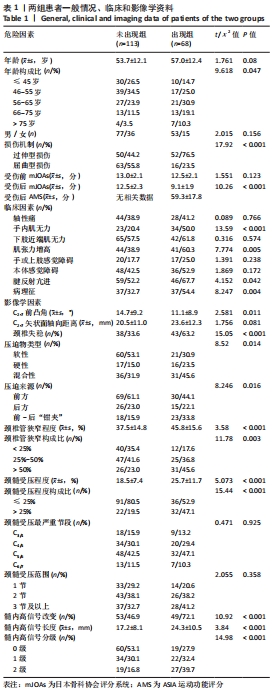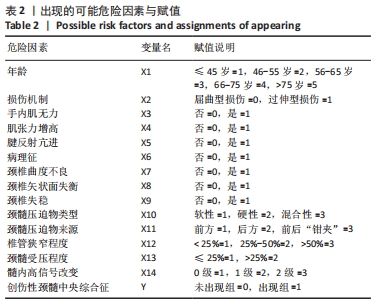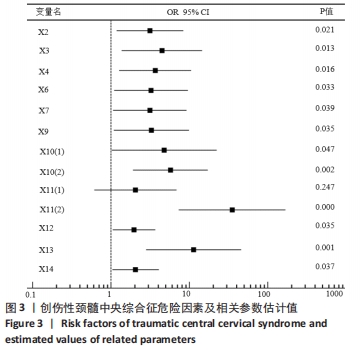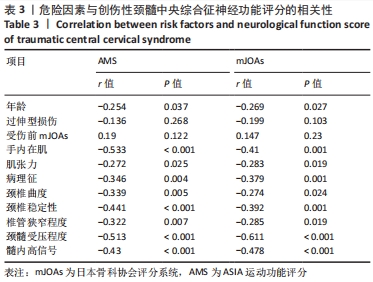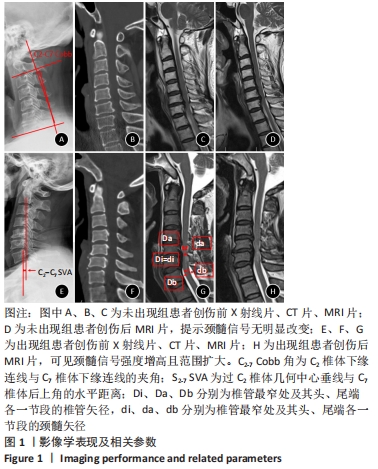[1] BOOGAARTS HD, BARTELS RH. Prevalence of cervical spondylotic myelopathy. Eur Spine J. 2015;24(2):139-141.
[2] ALJUBOORI Z, BOAKYE M. The natural history of cervical spondylotic myelopathy and ossification of the posterior longitudinal ligament: a review article. Cureus. 2019;11(7):e5074.
[3] 刘国臻,刘磊,王运涛.创伤性颈脊髓中央综合征的研究进展[J].中国脊柱脊髓杂志,2019,29(8):755-759.
[4] BAKHSHESHIAN J, MEHTA VA, LIU JC. Current diagnosis and management of cervical spondylotic myelopathy. Global Spine J. 2017;7(6):572-586.
[5] 杨海源,唐鹏宇,罗勇骏,等.颈脊髓中央管综合征手术治疗预后影响因素分析[J].中国骨与关节损伤杂志,2016,31(7):673-676.
[6] 张辉,徐南伟,农鲁明,等.颈脊髓中央管综合征钛板内固定和药物治疗的预后因素分析[J].中国组织工程研究,2020,24(3):348-353.
[7] GIANNOUDIS PV, MEHTA SS, TSIRIDIS E. Incidence and outcome of whiplash injury after multiple trauma. Spine (Phila Pa 1976). 2007;32(7):776-781.
[8] DYSKIN E, HILL BW, TORCHIA MT, et al. A Survey of High- and Low-Energy Acetabular Fractures in Elderly Patients. Geriatr Orthop Surg Rehabil. 2019; 10:1-6.
[9] 贾连顺.对过伸性颈脊髓损伤的再认识[J].中华外科杂志,2007,45(6): 363-365.
[10] 龙浩,肖杰,郭涛,等.下颈椎屈曲分离型损伤的临床特点与手术选择[J].创伤外科杂志,2012,14(1):24-26.
[11] 张黎龙,程招军,崔子健,等.MRI测量脊髓型颈椎病患者矢状位参数相关性分析[J].中国修复重建外科杂志,2017,31(4):451-454.
[12] KONG C, LI XY, SUN XY, et al. The ratio of C2-C7 Cobb angle to T1 slope is an effective parameter for the selection of posterior surgical approach for patients with multisegmental cervical spondylotic myelopathy. J Orthop Sci. 2020;25(6):953-959.
[13] 邓元,倪斌.颈椎矢状序列测量方法的研究进展[J].中国脊柱脊髓杂志, 2014,24(7):655-659.
[14] JOUIBARI MF, LE HUEC JC, RANJBAR HAMEGHAVANDI MH, et al. Comparison of cervical sagittal parameters among patients with neck pain and healthy controls: a comparative cross-sectional study. Eur Spine J. 2019;28(10): 2319-2324.
[15] LIN T, WANG Z, CHEN G, et al. Is Cervical Sagittal Balance Related to the Progression of Patients with Cervical Spondylotic Myelopathy? World Neurosurg. 2020;137:e52-e67.
[16] FEHLINGS MG, FURLAN JC, MASSICOTTE EM, et al. Interobserver and intraobserver reliability of maximum canal compromise and spinal cord compression for evaluation of acute traumatic cervical spinal cord injury. Spine (Phila Pa 1976). 2006;31(15):1719-1725.
[17] MIYANJI F, FURLAN JC, AARABI B, et al. Acute cervical traumatic spinal cord injury: MR imaging findings correlated with neurologic outcome-prospective study with 100 consecutive patients. Radiology. 2007;243(3):820-827.
[18] 张鹏,申勇,张英泽,等.MRI信号强度比值判断脊髓型颈椎病预后的意义[J].中华骨科杂志,2011,31(8):825-828.
[19] 李振宇,林宏生,李恒国.颈髓MRI T_2信号强度比在脊髓型颈椎病手术前后的应用价值[J].临床放射学杂志,2018,37(5):733-736.
[20] 刘忠军.对脊髓型颈椎病手术入路与术式的思考[J].中国脊柱脊髓杂志, 2009,19(7):481-482.
[21] 陈亮,杨惠林,杨同其,等.外伤性颈髓中央综合征的手术治疗[J].中华骨科杂志,2007,27(8):566-571.
[22] 叶一,蒋国强,程黎明.颈中央脊髓损伤综合征手术时间点与疗效的相关性[J].中华创伤杂志,2014,30(4):320-323.
[23] KARADIMAS SK, GATZOUNIS G, FEHLINGS MG. Pathobiology of cervical spondylotic myelopathy. Eur Spine J. 2015;24(2):132-138.
[24] 杨海源,蔡卫华.颈椎过伸性损伤机制与病理改变的研究进展[J].脊柱外科杂志,2016,14(2):117-120.
[25] WINKELSTEIN BA, NIGHTINGALE RW, RICHARDSON WJ, et al. The cervical facet capsule and its role in whiplash injury: a biomechanical investigation. Spine (Phila Pa 1976). 2000;25(10):1238-1246.
[26] 宋沛松,韩伟,崔华中,等.动态MRI评估过伸性颈椎损伤发生过程中椎管内容、椎体及椎间盘相关变化的意义[J].中国临床康复,2004, 8(26):5561-5563.
[27] YAMAZAKI T, YANAKA K, FUJITA K, et al. Traumatic central cord syndrome: analysis of factors affecting the outcome. Surg Neurol. 2005;63(2):95-99.
[28] 王林峰,申勇,张英泽,等.脊髓型颈椎病动态脊髓受压变化与疾病严重程度及预后的关系[J].中华医学杂志,2009,89(41):2883-2887.
[29] 竺得洲,高杰,李连华,等.急性创伤性中央颈髓综合征手术治疗的预后因素分析[J].中国脊柱脊髓杂志,2018,28(11):975-981.
[30] PAQUET J, RIVERS CS, KURBAN D, et al. The impact of spine stability on cervical spinal cord injury with respect to demographics, management, and outcome: a prospective cohort from a national spinal cord injury registry. Spine J. 2018;18(1):88-98.
[31] 顾勇,王强,辛天闻,等.颈椎后路椎管扩大成形置入微型钛板:矢状面参数变化与修复效果的关系[J].中国组织工程研究,2016,20(44): 6570-6576.
[32] NOURI A, TETREAULT L, ZAMORANO JJ, et al. Role of magnetic resonance imaging in predicting surgical outcome in patients with cervical spondylotic myelopathy. Spine (Phila Pa 1976). 2015;40(3):171-178.
[33] 李智斐,钟远鸣,张家立,等.动态MRI检测颈椎健康者、颈肩部不适者脊髓型颈椎病未确诊及确诊者的价值[J].中国组织工程研究与临床康复,2010,14(48):8998-9002.
[34] FARHADI HF, KUKREJA S, MINNEMA A, et al. Impact of admission imaging findings on neurological outcomes in acute cervical traumatic spinal cord injury. J Neurotrauma. 2018;35(12):1398-1406.
[35] VEDANTAM A, JONATHAN A, RAJSHEKHAR V. Association of magnetic resonance imaging signal changes and outcome prediction after surgery for cervical spondylotic myelopathy. J Neurosurg Spine. 2011;15(6):660-666.
[36] FERNANDEZ DE ROTA JJ, MESCHIAN S, FERNANDEZ DE ROTA A, et al. Cervical spondylotic myelopathy due to chronic compression: the role of signal intensity changes in magnetic resonance images. J Neurosurg Spine. 2007;6(1):17-22.
[37] AVADHANI A, RAJASEKARAN S, SHETTY AP. Comparison of prognostic value of different MRI classifications of signal intensity change in cervical spondylotic myelopathy. Spine J. 2010;10(6):475-485.
[38] AARABI B, HADLEY MN, DHALL SS, et al. Management of acute traumatic central cord syndrome (ATCCS). Neurosurgery. 2013;72(2):195-204.
|
